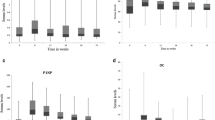Abstract
The progress of fracture union requires close monitoring. Whereas, clinical examination and radiographic studies assess the outcome, biochemical markers like serum alkaline phosphatase and urinary hydroxyproline reflect the actual status of bone resorption and bone formation over a short time frame. 36 patients of long bone fracture were randomly allocated for the study. When the patient reported to the Department of Orthopedics after fracture, serum and urinary samples were collected and X-ray of the affected part were taken. Subsequent samples were collected and X-ray taken just after management (either operative or conservative), after 3rd, 5th, 8th and 12th week, respectively after onset of fracture. According to the course of callus formation the patients were divided into two groups that progressed to proper union or malunion. The levels of serum alkaline phosphatase, urinary total and free hydroxyproline levels were measured and statistically analysed and compared. A statistically significant positive correlation between total urinary hydroxyproline excretion and serum alkaline phosphatase indicate progress towards satisfactory union. Thus, serial monitoring of biochemical markers of bone turnover can be used as an adjunct to clinical and radiological evidence of fracture healing.



Similar content being viewed by others
References
Camozzi V, Tossi A, Simoni E, Pagani F, Francucci CM, Moro L. Role of biochemical markers of bone remodeling in clinical practice. J Endocr Invest. 2007;30(Suppl 6):13–7.
NCCLS. Application of biochemical markers of bone turnover in the assessment and monitoring of bone disease. Approved guideline. NCCLS document C48-A (ISBN !-56238-539-9) NCCLS, 940 West Valley Road, Suite 1400, Wayne, Pennsylvania 19087-1898 USA, 2004.
Hamblen DL, Simpson AHRW. Adams outline of fractures including joint injuries. 12th ed. Toronto: Churchill Livingstone Elsevier; 2007.
Hoesel LM, Wehr U, Rambeck WA, Schnettler R, Heiss C. Biochemical bone markers are useful to monitor fracture repair. Clin Orthop Relat Res. 2005;440:226–32.
Christenson RH. Biochemical markers of bone metabolism—an overview. Clin Biochem. 1997;30(8):573–93.
Delmas PD. Biochemical markers of bone turnover. Acta Orthop Scand. 1995;66(Suppl 266):176–82.
Udenfriend S. Fromation of hydroxyproline in collagen. Science. 1966;152:1335–40.
Bergman I, Loxley R. The determination of hydroxyproline in urinary hydrolysates. Clin Chim Acta. 1979;96:125–30.
Bowers LD. Kinetic serum creatinine assay. I. The role of various factors in determining specificity. Clin Chem. 1980;26(5):551–6.
German Society for Clinical Chemistry, Standard method for determination of alkaline phosphatase (AP) activity. J Clin Chem Clin Biochem. 1972; 10:290.
Bagainski ES. Calcium estimation by OCPC method. Anal Biochem. 1973;18:521.
Prockop DJ, Kivirikko KI. Relationship of hydroxyproline excretion in urine to collagen metabolism. Ann Intern Med. 1967;66:1243–66.
Ashhurst DE. Collagens synthesized by healing fractures. Clin Orthop. 1990;255:273–83.
Drommer R. Urinary Hydroxyproline during the healing period of bone fractures. Z Orthop Ihre Grenzgeb. 1979;117(1):77–82. Authors German translation of original article.
Caulfield MP, Reitz RE. Biochemical markers of bone turnover and their utility in osteoporosis. Med Lab Obs. 2004;36(4):34–7.
Semb TH, Gudmundson CR, Westlin NE, Hallander LB. Alkaline phosphatase activity and isoenzymes in experimental fractures. Clin Chim Acta. 1971;31:375–80.
Erikson EE, Axelrod DW, Melsen F. Bone histomorphometry. New York: Raven Press; 1994.
Lal SK, Jacob KC. Variations of some plasma components after closed fracture. J Trauma. 1976;16:2006.
Wharton BA, GoughG, Willims A, Sheila K, Pennock CA. Urinary total hydroxyproline: creatinine ratio range of normal, and clinical application in British children. Arch Dis Child. 1972; 47(251): 74–9.
Howell JR, Wharton BA, McCance RA. Value of hydroxyproline indices in malnutrition. Lancet. 1967;1:1082.
Author information
Authors and Affiliations
Corresponding author
Rights and permissions
About this article
Cite this article
Mukhopadhyay, M., Sinha, R., Pal, M. et al. Role of Common Biochemical Markers for the Assessment of Fracture Union. Ind J Clin Biochem 26, 274–278 (2011). https://doi.org/10.1007/s12291-011-0143-1
Received:
Accepted:
Published:
Issue Date:
DOI: https://doi.org/10.1007/s12291-011-0143-1




